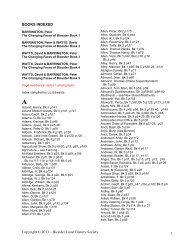Draft Bicester Conservation Area Appraisal November 2009
Draft Bicester Conservation Area Appraisal November 2009
Draft Bicester Conservation Area Appraisal November 2009
You also want an ePaper? Increase the reach of your titles
YUMPU automatically turns print PDFs into web optimized ePapers that Google loves.
6.3 Trade, Industrial andAgricultural Interest6.3.1 The development of the market townfrom an agrarian community can becharted. At the beginning of the 17thcentury the settlement was almost entirelydependent on agriculture with fewtradesmen. By 1622 however a travellerdescribed <strong>Bicester</strong> as ‘a very good marketfor all manner of cattle supplied with allkinds of trades’. Analysis of wills of theperiod reveals that tanners, glovers,saddlers, clothiers, weavers, fullers andmaltsters all traded in the town. By the18th century over a quarter of thetownspeople were suppliers of goodsincluding meat, bread, shoes and clothing.By 1851, although agriculture was still thegreatest source of employment in thetown, there were also labourers,carpenters, masons and, amongst thewomen of the poorer classes, lacemakers, dress makers, tailors andmilliners. By the 18th century <strong>Bicester</strong> hasestablished a reputation for rope, lace,baskets, sackcloth and combing wool andplaiting straw.6.3.2 Market End was inclosed in 1758and King’s End in 1793. Until that timeopen fields existed as far as Chestertonand Middleston Stoney. Thomas Williams’1754 map prepared just before theInclosure Act clearly shows the division ofland into furlongs. The agriculturalindustry of the area is varied. The blackdeath affected the town and this, witheconomic decline, poor harvests andfloods, created harsh times. Much landwas uncultivated and sheep farming andland inclosure took over from arablefarming. Market End fields and commonswere finally inclosed in 1757 and KingsEnd in 1794. After inclosure rents trebled.By the 1820s there was severedepression caused by the Napoleonicwars. However by the end of the 19thcentury <strong>Bicester</strong> District was well farmedand the area was noted for its butter andcheese production.Sheep Street in 19106.3.3 Improved communications camewith the construction of turnpikes, theOxford Canal, (with a wharf at LowerHeyford), the London and North WesternRailway line from Bletchley to Oxford in1850 and the Great Western Railwayfollowing in 1910. The industrialrevolution affected <strong>Bicester</strong> less thanmany other towns. The decline of themarket and through coaching traffic in the19th century did not result in ruin, due tothe prosperity which was brought to thetown by the horse races and hunts. Horseraces were initially held at King’s End butlater transferred out of town.Beesley, A. History of <strong>Bicester</strong> (1821),Vol. 15, pg 3619



